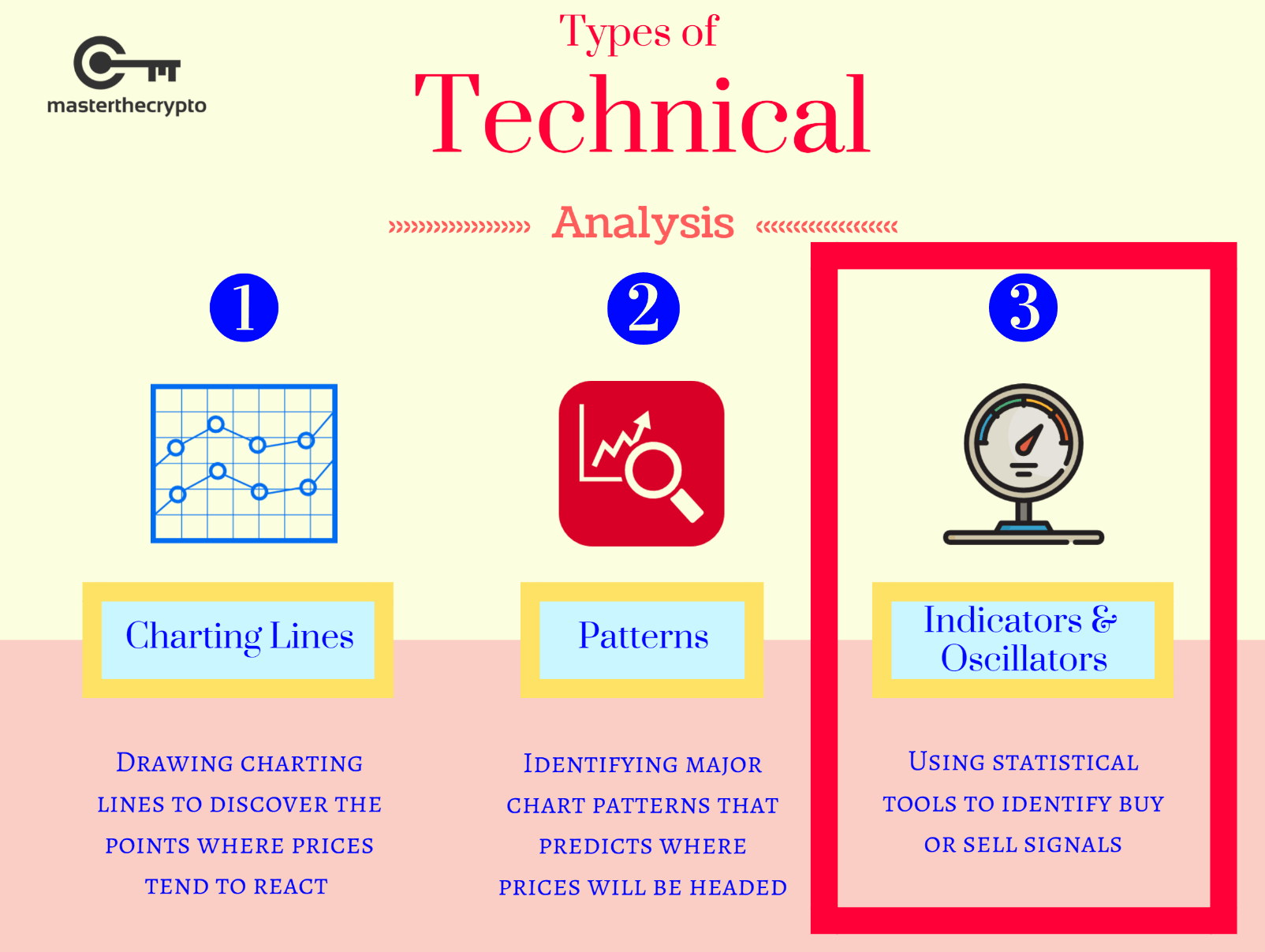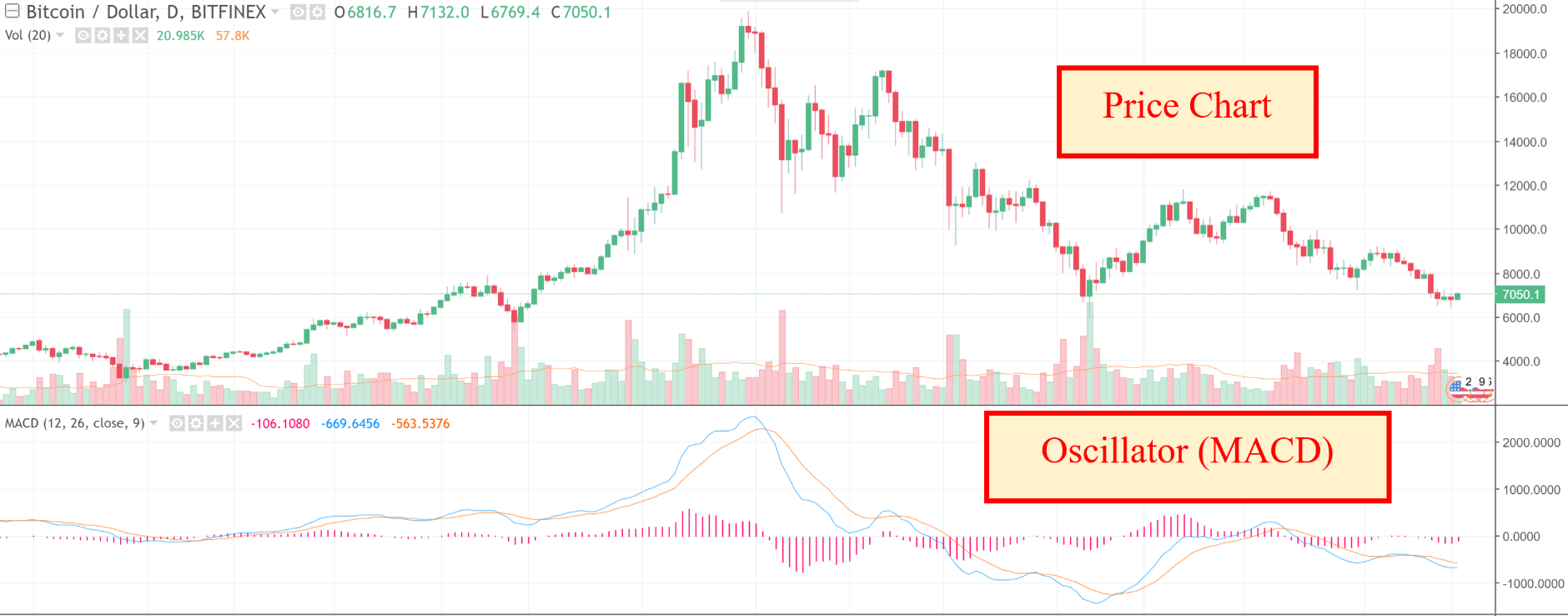This guide to crypto technical analysis will take you along the exciting introduction to technical indicators that are widely used in technical analysis.

There are three major components of Technical Analysis as shown above. This guide will look at technical indicators and oscillators, and how you can use them to your advantage.
Introduction to Technical Indicators
Technical indicators are tools used to measure and interpret market behaviour. They are often used by investors and traders to assist them with trade timing or to alert them to new trends; whether prices will be going up, down or sideways. Technical indicators are created using mathematical calculations of historical prices and trading volume of the particular asset (or cryptocurrency), in a bid to predict the market trend. (See more: Cryptocurrency Trading: Understanding Cryptocurrency Trading Pairs & How it Works)
Here are examples of technical indicators:

The above example shows 2 popular technical indicators: Moving Average Convergence Divergence (MACD) and Relative Strength Index (RSI). It’s good if you can understand the mathematics behind the indicators themselves, but it’s not a requirement for you to use it since these indicators are represented in a visual way and are easy to follow. All you have to understand is how to use the indicator, not how it works. (Read also: A Guide To Fundamental Analysis For Cryptocurrencies)
We’ll discuss more in details about the usage of both indicators in future articles.
Why Should We Use Indicators?
Indicators represent an important part of technical analysis. The functions of technical indicators are as follows:
- Prediction: Indicators are used to predict the direction of future prices
- Confirmation: In order to confirm a particular trend or price movement, indicators are a great way to confirm and complement your technical analysis
- Alert: Indicators are used to alert investors/traders of the momentum of the market, and to make the necessary arrangements for trades
Technical indicators are often used by active traders, as they're designed to evaluate short-term price movements. However, investors that are geared towards the long-term can also use technical indicators to identify entry and exit points.
Technical indicators are powerful tools that can be utilized to turn price patterns into actionable trading plans.
(Read also: Crypto Trading Guide: 4 Common Pitfalls Every Crypto Trader Will Experience)
Types of Technical Indicators
There are generally 2 basic types of technical indicators:
- Overlays: Overlays are indicators that are displayed (superimposed) over the main price chart

- Oscillators: Indicators that “oscillate” between an upper and lower limit, separated by a midpoint. Its value helps to determine the strength and momentum of the trend

Which Indicators Should I Use?
There are literally thousands of indicators and oscillators that traders can choose when analyzing a particular cryptocurrency or token. In order for you to choose which to choose from, it’s important to understand how the different technical indicators work and how they suit your strategy. Don’t worry, we’ve taken the liberty to handpick a couple of popular technical indicators that you can use with ease.
Do stay tuned!
(Read also: Guide to Common Crypto Terms)
Beneficial Resources To Get You Started
If you're starting your journey into the complex world of cryptocurrencies, here's a list of useful resources and guides that will get you on your way:

Trading & Exchange
- Crypto Guide 101: Choosing The Best Cryptocurrency Exchange
- Guide to Bittrex Exchange: How to Trade on Bittrex
- Guide to Binance Exchange: How to Open Binance Account and What You Should Know
- Guide to Etherdelta Exchange: How to Trade on Etherdelta
- Guide To Cryptocurrency Trading Basics: Introduction to Crypto Technical Analysis
- Cryptocurrency Trading: Understanding Cryptocurrency Trading Pairs & How it Works
- Crypto Trading Guide: 4 Common Pitfalls Every Crypto Trader Will Experience
Wallets
- Guide to Cryptocurrency Wallets: Why Do You Need Wallets?
- Guide to Cryptocurrency Wallets: Opening a Bitcoin Wallet
- Guide to Cryptocurrency Wallets: Opening a MyEtherWallet (MEW)
Read also: Guide on Privacy Coins: Comparison of Anonymous Cryptocurrencies and Analyzing Cryptocurrency Risk: Existing Coins vs ICO
Get our exclusive e-book which will guide you on the step-by-step process to get started with making money via Cryptocurrency investments!
You can also join our Facebook group at Master The Crypto: Advanced Cryptocurrency Knowledge to ask any questions regarding cryptos!

I'm Aziz, a seasoned cryptocurrency trader who's really passionate about 2 things; #1) the awesome-revolutionary blockchain technology underlying crypto and #2) helping make bitcoin great ‘again'!

